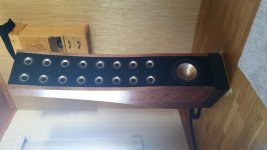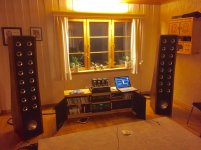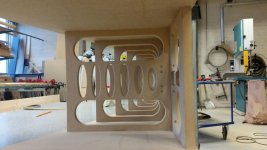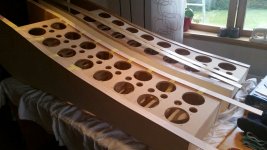Just for amuse/confusment 🙂
A (very) old line source project that turned into something different:
A curved open3-way active MTM+SUB baffle Radius is approx 5,4meter
We intend to place the holy listening chair between origo (circle's center) and speaker where the listening window height is 50 cm.
This will be the reference distance for measurements, eq and Dirac compensation.
A (very) old line source project that turned into something different:
A curved open3-way active MTM+SUB baffle Radius is approx 5,4meter
We intend to place the holy listening chair between origo (circle's center) and speaker where the listening window height is 50 cm.
This will be the reference distance for measurements, eq and Dirac compensation.
Attachments
Last edited:
The directionality will clean up any embedded imaging cues in the program material, and reduce floor and ceiling bounce comb filter effects, and in the lower midrange where interaural crosstalk blurrs imaging, the rear emission will recreate a sense of space, but off axis they lose warmth. The only real downside in my opinion is that OB speakers need to be at least 3 feet (or one meter) away from any walls, or there is a negative psycho-acoustic effect. If you room is small this can be an issue.
An interesting experiment might be to wire the outer row of 5 inch (?) drivers separate from the inner ones, so you can do the Polk Hologram thing, where you connect the outer vertical row of midrange drivers with reverse phase to the opposite channel. I've tried this and it works great if you don't mind sitting in the exact center of the approximate triangle, if you know what I mean. The soundstage will expand horizontally wall to wall, and each sound will have more space around it. You can always switch it back if you don't like it.
An interesting experiment might be to wire the outer row of 5 inch (?) drivers separate from the inner ones, so you can do the Polk Hologram thing, where you connect the outer vertical row of midrange drivers with reverse phase to the opposite channel. I've tried this and it works great if you don't mind sitting in the exact center of the approximate triangle, if you know what I mean. The soundstage will expand horizontally wall to wall, and each sound will have more space around it. You can always switch it back if you don't like it.
very very nice.
I've had stuff made but using full range drivers like that and it was some of the best I'd ever heard.
But that will be 1 chair only. sideways mtm usually sound funny to me off axis.
I've had stuff made but using full range drivers like that and it was some of the best I'd ever heard.
But that will be 1 chair only. sideways mtm usually sound funny to me off axis.
Thank you very much. The Polk idea is amazing, we will for shure experiment with " holo- cast" ����
It's known as the SDA effect. I can't say for certain as I don't have a schematic handy, but I believe the inner drivers are "out of phase" and the outer drivers are 3db more efficient. This varied model to model, but I believe above is the general gist of their more desirable SDA models.An interesting experiment might be to wire the outer row of 5 inch (?) drivers separate from the inner ones, so you can do the Polk Hologram thing, where you connect the outer vertical row of midrange drivers with reverse phase to the opposite channel. I've tried this and it works great if you don't mind sitting in the exact center of the approximate triangle, if you know what I mean. The soundstage will expand horizontally wall to wall, and each sound will have more space around it. You can always switch it back if you don't like it.
Everything you need to know: http://www.vr3mods.com/uploads/SDA_Handbook_2011_Rev2.pdf
I've messed around with this, and found that the best place to put the cancellation speakers is right at the listeners seat.
Here's why:
Crosstalk cancellation widens the stage. In the eighties, we had no DSP, so we put the cancellation speakers right next to the speakers. A la Polk SDA.
But here in 2016, an $80 minidsp can delay your cancellation speakers, allowing you to put them where they're most effective: the listeners seat.
Besides sounding better, it also allows you to use cancellation speakers at a lower SPL (because they're closer)
By using less wattage for the cancellation speakers, you improve the bass and dynamics. (Because the cancellation speakers will obviously reduce the bass and dynamics with their out of phase signal.)
This is an easy cheap project, I used a pair of cheap Cambridge satellites for my cancellation speakers, with kef speakers for the mains. Worked really nice.
Here's why:
Crosstalk cancellation widens the stage. In the eighties, we had no DSP, so we put the cancellation speakers right next to the speakers. A la Polk SDA.
But here in 2016, an $80 minidsp can delay your cancellation speakers, allowing you to put them where they're most effective: the listeners seat.
Besides sounding better, it also allows you to use cancellation speakers at a lower SPL (because they're closer)
By using less wattage for the cancellation speakers, you improve the bass and dynamics. (Because the cancellation speakers will obviously reduce the bass and dynamics with their out of phase signal.)
This is an easy cheap project, I used a pair of cheap Cambridge satellites for my cancellation speakers, with kef speakers for the mains. Worked really nice.
Finished
The CuBa luckily proved to achieve its goals.
Crossover is MiniDSP 4 HD together with Dirac Live amplified by Anaview.
The listening window is tuned (by dirac mic) to approx 0,5 height.
Crossover got the much preferable Harsch topology.
Visiting listeners says that dynamics are similar to big horns, but completely without any stressed notes. Sound space are wide, deep and detailed.
When you leave the listening chair, the optimal scene and micro details flattens out. The single 10" Seas ROY got enough capacity for all types of music, but a 15" sub-woofer will add additional tactile drama.
The concept with full directivety and equal distance tempted us to start another project, but not an open baffle this time, but a curved closed array.
A new thread will follow by soon. (The 16 tweeters are not visible on the pictures as they are hidden behind a thin fabric)


The CuBa luckily proved to achieve its goals.
Crossover is MiniDSP 4 HD together with Dirac Live amplified by Anaview.
The listening window is tuned (by dirac mic) to approx 0,5 height.
Crossover got the much preferable Harsch topology.
Visiting listeners says that dynamics are similar to big horns, but completely without any stressed notes. Sound space are wide, deep and detailed.
When you leave the listening chair, the optimal scene and micro details flattens out. The single 10" Seas ROY got enough capacity for all types of music, but a 15" sub-woofer will add additional tactile drama.
The concept with full directivety and equal distance tempted us to start another project, but not an open baffle this time, but a curved closed array.
A new thread will follow by soon. (The 16 tweeters are not visible on the pictures as they are hidden behind a thin fabric)


Last edited:
Last edited:
Thank you guys! The next thread about curved array will be named "Bendit".
Maybe "sector array" is a better description as the line is a part of a circle (R=5,2m)?
Maybe "sector array" is a better description as the line is a part of a circle (R=5,2m)?
- Status
- Not open for further replies.
- Home
- Loudspeakers
- Multi-Way
- CuBa curved open baffle




